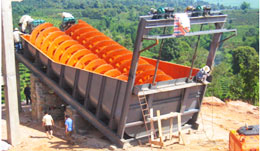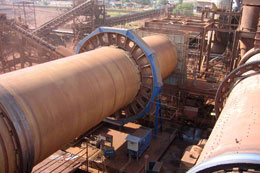-
Sand Making Crusher
- PCL-Vertical Shaft Impact Crusher
- SBM Hydraulic VSI Crusher
- VSI5X Series Impact Crusher
Ochre Crusher
Ochre resources, industry application and ochre crusher, ochre grinding mill

The ochre has other name ferritungstite, Tungstite Ferritungstite, Tungstite. Depending upon the colour, the ochres are called red ochre, yellow ochre, green earths, sienna, umber and by various other names. In addition to red ochre, the red oxide of iron, commonly called 'red oxide', is an important natural pigment. It results from the alteration of hematite and ferruginous laterite and consists essentially of Fe 2 O 3 having pigmentary quality. The principal use of ochre is as tinting colours. It is used for colour washes, distemper and oil paints. It is also used in making coloured paper. Ochres are the natural mineral pigments occuring in various shades and colours, generally ranging from yellow to red to brown. The colouring power is mainly due to oxides of iron.
Preparation of pigments from red oxide requires an elaborate process. Since it is hard, it has to undergo milling and finally separation of the coarse particles by elutrition. Ochres being friable are crushed and lixivated, just like china-clay, to obtain extremely fine-textured material of uniform colour. Refining by elutriation followed by drying often improves both iron content and colour. The staining power, brilliance and fineness of texture are the main properties by which an ochre is judged for its quality and value in industry.
Ochre occurrence
The highest red oxides are found along the Persian Gulf and in Spain. The Persian deposit is mined on the Omur island. A brown oxide found in pnnsylvannia, USA, is known as metallic brown.
Ochre uses and application

The principal use of ochre is as tinting colours. It is used for colour washes, distemper and oil paints. It is also used in making coloured paper. For this particular use ochre and china-clay or soapstone, after dissolving in water in paste form, are acreened and added in the beater for the prepareation of coloured paper pulp. Red oxide pigments are widely used as primers for painting structural steel, automobile bodies, ship bottoms etc.
Ochre Pigment Information
Ochre is a natural earth containing silica and clay tinted by hydrous forms of iron oxide, such as yellow-brown limonite or brown-yellow to green-yellow goethite, and traces of gypsum or manganese carbonate. Limonite is a general term used to describe all forms of hydrated iron oxide minerals that occur as natural clay or earth.
Ochre crusher & ochre grinding mill

As the ochre’s application in industry you should use our ochre crusher and ochre grinding mill. When you get the primary ochre, it is always in different types of big block, so the ochre need to be crushed, sieved and graded into various sizes and thus coated abrasives of various fineness are prepared. In the process you may be use the ochre jaw crusher, ochre impact crusher, ochre cone crusher, vsi ochre crusher, mobile ochre crusher, trapezium ochre grinding mill, ochre ultrafine grinding mill, ochre ball mill grinder etc.
- Limestone Crusher
- Barite Crusher
- Granite Crusher
- Kaolinite Crusher
- Calcite Crushing
- Tombarthite Crusher Mill
- Bentonite Crusher
- Basalt Ore Crusher
- Lignite Crusher Mill
- Silica Ore Crusher
- Tin Ore Mine
- Lead and Zinc Ore Crusher
- Ochre Crusher Mill
- Garnet Crusher
- Mica Crusher
- Asbestos Crusher
- Manganese Ore Crusher
- Talc Crusher Mill
- Feldspar Crusher
- Iron Ore Crusher
- Dolomite Crusher
- Quartz Crusher
- Gypsum Crusher
- Calcium Carbonate Grinding
- Salt quarry
- Salt mining
- Salt process
- Salt grinding
- Salt crushing
- Kaolin quarry
- Kaolin beneficiation
- Kaolin mining
- Kaolin grinding
- Kaolin crushing
- Kaolin processing
- About Us
- |
- Service
- |
- News & Events
- |
- Contact Us
- |
- Resources
- |
- Showroom
Aggregate Crusher
Artificial Sand Making
Ballast Crushing Machine
Basalt Stone Crusher
Barite Mine Process
Beneficiation Plant
Bentonite Crusher
Bentonite Milling
Calcium Carbonate Crusher
Calcium Carbonate Grinding
Cement Grinding
Concrete Crusher
Coal Crusher
Copper Crusher
Cement Mill
Chrome Mining Process
Copper ore Beneficiation
Coal Processing
Coal Pulvarizer
Feldspar Crushing
Feldspar Grinding
Flotation Machine
Gold Crusher
Gold Mine Equipment
Gold Processing Machinery
Granite Crusher
Granite Crushing Machine
Granite Quarry Equipment
Gypsum Crusher
Gypsum Mining
Gypsum Powder Production
Iron Ore Beneficiation
Iron Ore Crusher
Kaolin Processing Plant
Limestone Crusher
Silica Sand Crusher
Iron Ore Mining Equipment
Cement Production Line
Talc Production Line
Quartz Crushing Machine
Limestone Mining Process
Manganese Benificietion
























